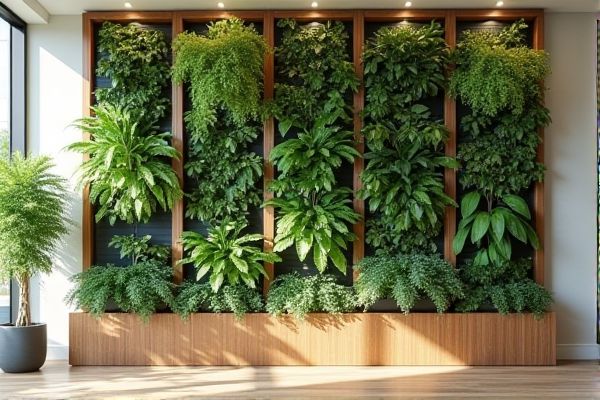
Vertical gardens maximize space by integrating live plants directly onto walls, creating a lush, green ecosystem, whereas wall planters are containers affixed to walls that hold soil and plants, offering flexible and decorative planting options. Discover how each method can transform your living space and which suits Your home best in the rest of the article.
Table of Comparison
| Feature | Vertical Garden | Wall Planter |
|---|---|---|
| Definition | A living green wall system with multiple plants arranged vertically. | A container or pocket attached to a wall for individual plants. |
| Plant Capacity | High, supports many plants simultaneously. | Limited, typically supports fewer plants. |
| Installation | Requires professional setup and structural support. | Easy DIY installation. |
| Maintenance | Moderate to high; needs irrigation and regular care. | Low to moderate; easier watering and cleaning. |
| Design Flexibility | Highly customizable layouts and plant diversity. | Limited to planter shapes and sizes. |
| Cost | Higher initial investment. | Generally affordable. |
| Best Use Case | Large spaces for green walls, urban gardening. | Small spaces, decorative accents. |
Introduction to Vertical Gardens and Wall Planters
Vertical gardens and wall planters both maximize limited space by enabling greenery on vertical surfaces, enhancing urban aesthetics and air quality. Vertical gardens often incorporate a layered system with integrated irrigation, supporting diverse plant species and creating living walls. Wall planters are typically modular containers attached directly to walls, focusing on ease of installation and maintenance for smaller-scale horticulture.
Design Differences: Vertical Gardens vs Wall Planters
Vertical gardens utilize modular panels or pocket systems that cover large wall areas, creating dense, living murals with integrated irrigation and drainage. Wall planters are individual pots or containers mounted separately, offering flexibility in arrangement but less continuous plant coverage. Your choice depends on whether you prefer a cohesive green facade or customizable, spaced-out plant displays.
Space Efficiency: Which Saves More Space?
Vertical gardens maximize space by using entire wall surfaces, allowing you to grow a variety of plants vertically without occupying floor area. Wall planters, while also mounted on walls, typically offer smaller planting spaces and may limit the number of plants you can cultivate. For optimal space efficiency, vertical gardens generally save more space by maximizing vertical growth potential in compact areas.
Installation Process Compared
Vertical gardens often require a more complex installation process involving structural support, irrigation systems, and proper waterproofing to sustain living plants. Wall planters are typically easier to install, usually mounted directly on walls with hooks or brackets, making them ideal for simpler setups or seasonal changes. Your choice depends on whether you prefer a low-maintenance solution or a lush, customizable green space.
Plant Selection and Compatibility
Vertical gardens offer a broader range of plant selection, including trailing vines, succulents, and herbs, due to their multi-layered structure and soil depth. Wall planters typically support smaller, shallow-rooted plants like ferns or flowers, as their design limits soil volume and moisture retention. Choosing the right option depends on Your plant variety preferences and the growing requirements of each species to ensure optimal compatibility and growth.
Maintenance Requirements for Each Option
Vertical gardens require regular watering, pruning, and nutrient management to ensure plant health and optimal growth, often benefiting from automated irrigation systems to reduce maintenance time. Wall planters typically demand less frequent attention, as their smaller soil volume limits root expansion and water retention, but they still need periodic watering and occasional fertilization. Your choice should consider how much time you can dedicate to plant care, as vertical gardens generally need more consistent upkeep compared to wall planters.
Aesthetic Appeal and Customization
Vertical gardens offer a lush, living tapestry that transforms any wall into a vibrant, natural art piece, enhancing your space's aesthetic appeal with diverse plant varieties. Wall planters provide sleek, minimalist designs ideal for structured arrangements, allowing precise customization to fit your decor style. Both options enable personalization, but vertical gardens excel in creating dynamic, multi-dimensional displays that evolve over time.
Cost Analysis: Initial and Long-term Expenses
Vertical gardens typically involve higher initial costs due to structure installation, irrigation systems, and specialized plants, while wall planters offer a more budget-friendly setup with basic containers and manual watering. Over time, vertical gardens may accrue additional expenses from maintenance, system repairs, and plant replacement, whereas wall planters generally require lower ongoing costs with simpler upkeep. Evaluating long-term value depends on factors such as space, plant selection, and desired complexity, influencing both financial investment and sustainability.
Environmental Impact and Benefits
Vertical gardens enhance urban biodiversity by supporting pollinators and improving air quality through natural filtration, while wall planters offer localized benefits by reducing heat absorption on building surfaces and conserving water efficiently. Both systems contribute to energy savings by insulating structures and reducing cooling costs, with vertical gardens providing larger green spaces that better mitigate urban heat island effects. Your choice depends on space constraints and environmental goals, as vertical gardens deliver broader ecological benefits and wall planters optimize microclimates in compact areas.
Choosing the Right Solution for Your Space
Vertical gardens maximize greenery in limited spaces by allowing dense plant arrangements on structures, ideal for small balconies or urban areas. Wall planters offer a more decorative and customizable option, providing individual containers that can be rearranged or replaced based on plant needs and aesthetic preferences. Selecting the right solution depends on space constraints, maintenance capability, and desired visual impact, with vertical gardens suited for abundant foliage and wall planters best for versatility and ease of care.
 homyna.com
homyna.com